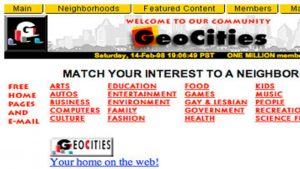(ThyBlackMan.com) The internet truly became widespread for commercial and recreational use during the 1990s. Plenty of resources, time, and effort went into developing TCP/IP via its use in ARPANET, the internet’s predecessor.
When the internet was in a usable state, those decades of development and the resources put into it had to make money somehow. Sure, there were other intentions for the internet but if there is even a flicker of potential commercial use in a new technology, it will be spiraled into that direction. Factor in that computers were now more available price-wise and had a place in public libraries and schools, the internet was going to spread rapidly.
Between the second half of the 1990s and the early 2000s, the internet gave us some things that became part of online culture and legend. Let’s look at a few of these relics of decades gone. Here’s seven things from the 90s internet and computers that you probably forgot.
Mosiac and Netscape Navigator
While there were contemporary web browsers, Mosiac was the OG of modern browsers. The graphical interface and general navigation that we appreciate in stuff like Chrome and Firefox today has it roots with Mosiac. This is a browser that dropped in 1993, before home PCs and home internet really exploded in the U.S.
Then Netscape Navigator came along at the end of 1994. If you started using the internet any time between 1994 and 1996, chances are high that you either used Netscape’s browser or you’ve seen it before. Netscape Navigator pushed what Mosiac did a little further while being largely built off of it—the core team that worked on Mosiac would head over to Netscape.
The funny thing is that Netscape’s original focus wasn’t to corral the internet into a form where the public could use it. Originally, the team wanted to do an online gaming service for the Nintendo 64—which wouldn’t be announced until 1995 and released the following year.
Netscape Navigator had an early lead as the top web browser but would later fall to Microsoft’s Internet Explorer before the 1990s was out.
Prompts From The Start
I first used the internet in the summer of 1996 with it being accessible at our local library. At 11, I was amazed by everything you could do on it and nagged my mother to get us the internet at home. The computer we had was donated to my younger brother by our school but it was dated by almost a decade.
This was how we learned basic prompts. They were necessary to get anything working since this computer—an old Macintosh II without the mouse—apparently didn’t have a GUI (graphical user interface). So, there wasn’t much we could do with it but play floppies of stuff like Family Feud, Jeopardy, and Gertrude’s Secrets.
It was rough, and learning prompts from the A-drive to the specific game on a floppy I’m trying to play just wasn’t as rewarding but it was useful years later.
Make Your Own Homepage with Geocities and Angelfire
Geocities was a home for plenty of fan stuff during the late 90s and early 00s. You could easily make your own homepage with the help of backgrounds and site templates. You also had toolbars to help you design it if you didn’t want to use HTML—or didn’t have the skills for HTML at all. Now Angelfire offered the same but it was a great way to learn HTML with no actual risk.
The thing with Angelfire is that you could get a preview of your homepage and the progress you’ve made. Ultimately, it was just easier to use Angelfire to design your site for what you need but Geocities had a larger concentration. In a lot of cases, once Yahoo called it quits on Geocities, a lot of folks headed over to Angelfire, Lycos, and FreeWebs (now Webs from Vistaprint).
Whether it was Geocities, Angelfire, or Lycos you had to get your site involved in a webring for promotion and more views. The guestbook for visitors to sign and the view counter were mandatory.
The Files Downloading Animation
This is one that everyone should remember. The Microsoft default gray and blue box that featured an animation of paper files flying into a folder—meant to indicate the drive destination. Now, the animations were never the main thing to watch but it’s one of things you’d remember. The main thing to keep an eye on was the progress bar which was indicated by a bar being filled by smaller—often Microsoft default blue—bars.
This could be a mildly dramatic situation back then because if you didn’t keep up with how much space you had on a disk or your hard drive, that progress bar would stop and let you know there was no space. Or if you had some particularly sorry dial-up and that download took a while to finish. Now, the download animation is more streamlined depending on the OS and browser.
Imagine all of this and there was no resume download.
Windows and Apple in the 90s
I attended school for graphic design and logos are one of things that left an impression. The two logos that were truly iconic were the pre-late 90s Windows logo and Apple’s spectrum logo (the color bands). You’d see Apple’s logo in a few advertisements, in PC World, and on Macintosh computers of the period. I’d get on the computer at the library to play Super Word Munchers or Mavis Beacon Teaches Typing there it was. Apple’s multi-colored logo.
As for Microsoft Windows, I saw that logo more often than Apple’s after a while. Windows 95, 98, and 2000 were very widespread OS because—like Android on mobile—it could be the OS for any non-Apple computer. The sound suite for every action with Windows is engrained in my memory.
CompuServe and America Online
It’s hard to forget America Online since so many of those free hours CDs were printed and put in magazines and the mail. Some might forget that America Online also came in floppy disks but America Online got around although readily. CompuServe was a similar service that was my exposure to chat rooms. Again, not a service that was used locally often.
Oddly enough, CompuServe didn’t end up getting the hate that America Online’s service did. Probably because CompuServe popularized a lot of online things such as email and was the major company as far as providing services since the late 1980s. It also wasn’t as aggressive as America Online.
Chat Rooms and Message Boards
During the 1990s and early 2000s, chat rooms weren’t necessarily the best way to connect with others instantly but they were the most readily accessible. Yahoo and America Online had their own scenes which were focused around chat rooms initially before giving way to Clubs and Groups. Clubs and groups gave way to message boards which allowed administrators to manage their communities directly.
Message boards were around the same time and became popular towards the end of 90s as chat rooms began to fall out of favor. Too many incidents of shadiness and criminal behavior came out of chat rooms. That isn’t to say that message boards didn’t harbor this kind of conduct as well but once it hit on Yahoo and America Online stuff, it made news.
Chat rooms gave way to instant messengers where you could largely controlled who you spoke to and when. In chat rooms, it was the wild west. Everyone was talking, some people spammed, and it got old the older you got online. Chat rooms still exist and their most mainstream application is via live streaming for comments from the viewing audience. Although, now with mobile phones, chat is far more annoying than it was in 2000s.
Message boards pretty much gave way to social media sites.
What are some of the things from the 90s or early 00s internet that you remember fondly—or gives you nightmares. Let us know!
Staff Writer; M. Swift
This talented writer is also a podcast host, and comic book fan who loves all things old school. One may also find him on Twitter at; metalswift.

















Leave a Reply